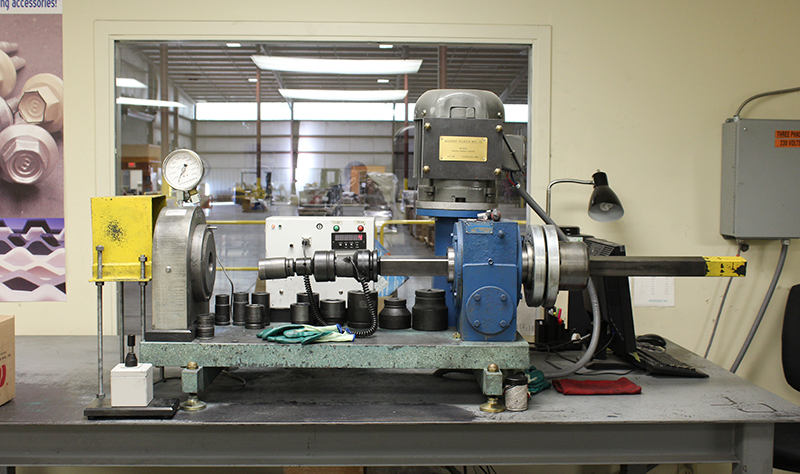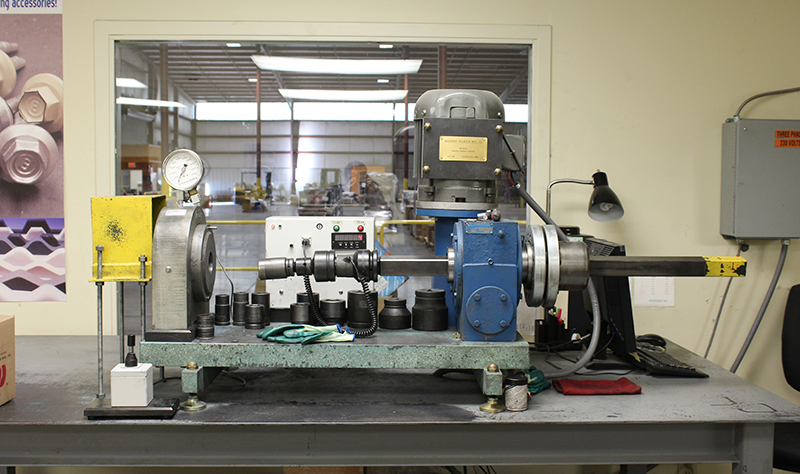Torque vs. Tension – What’s More Important in Structural Bolting?

Torque vs. Tension: Why Torque is Not a Reliable Means for Measuring Tension
Often, our customers will ask us to discuss torque values in regards to pretensioning structural bolts. Birmingham Fastener makes it a point to educate our customers on the difference between torque vs. tension and the importance of measuring the tension of structural bolts instead of just relying on torque.
Torque is often associated with installation, tightening, or inspection of structural bolts. Bolts are tightened in order to achieve tension – torque is only a by-product of this relationship to reach proper tension. Torque can vary greatly in this relationship to reach the desired tension, therefore, Birmingham Fastener stresses that you focus on tension first and foremost.
Lubrication, bearing surface condition, thread fit, and the use of a flat washer are some of the variable in the torque-tension relationship. About 60% of the torque required to tighten a bolt is consumed by overcoming the friction between the nut and the flat washer, about 30% overcoming the friction between bolt and nut threads, and 10% to elongate the bolt. According to multiple tests, torque-tension relationships can vary by as much as 40% for structural bolts.
Torque charts are not permitted to be used for installation or inspection. The only accepted method is the use of a Skidmore Wilhelm device (Bolt Tension Measurement Device) to actually measure tension, then proceed to measure the torque required. The charts below are listed for convenience and can be used to estimate the torque ranges for our structural bolts.
Measuring the Torque-Tension Relationship
The following is the basic equation to estimate the torque-tension relationship:
T = K x P x D
Where:
T = torque in foot-pounds
K = coefficient of friction
P = bolt tension in foot-pounds
D = Bolt diameter in inches
An accepted industry value for K is 0.0167. That said, lubrication or a lack of lubrication can cause the K factor to range from 0.01 to 0.025.
The tables below are estimated of the approximate torques for F3125 Grades A325 and A490 structural bolts. Because torque can vary so greatly, these tables are not to be used for installation or inspection purposes.
F3125 Grade A325 Approximate Torques (foot-pounds)
Note: These are estimates only and are not to be used for installation or inspection purposes. Torque can vary greatly depending on several factors listed above. Tension is actually what you are trying to achieve.
| Bolt Diameter | Required Tension Kips | Torque Average |
| 1/2" | 12 | 100 |
| 5/8" | 19 | 200 |
| 3/4" | 28 | 350 |
| 7/8" | 39 | 550 |
| 1" | 51 | 850 |
| 1-1/8" | 56 | 1050 |
| 1-1/4" | 71 | 1500 |
| 1-1/2" | 103 | 2600 |
F3125 Grade A490 Approximate Torques (foot-pounds)
Note: These are estimates only and are not to be used for installation or inspection purposes. Torque can vary greatly depending on several factors listed above. Tension is actually what you are trying to achieve.
| Bolt Diameter | Required Tension Kips | Torque Average |
| 1/2" | 15 | 130 |
| 5/8" | 24 | 250 |
| 3/4" | 35 | 450 |
| 7/8" | 49 | 700 |
| 1" | 64 | 1100 |
| 1-1/8" | 80 | 1500 |
| 1-1/4" | 102 | 2100 |
| 1-1/2" | 148 | 3700 |


The Power of Finding the Right Partner

Focus on What
Matters Most
Related Posts

DTI Washers and TC Bolts: Helping Ensure Torque and Tension

ASTM F3125: What Kind of Structural Bolts Does it Cover?




